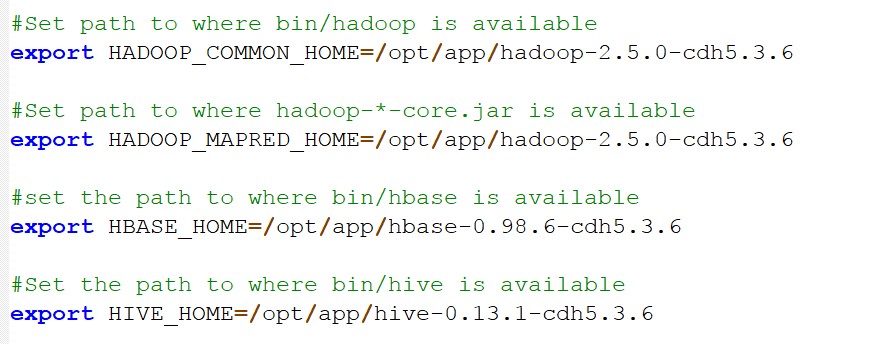flume是实时收集的一种大数据框架
sqoop是一个数据转换的大数据框架,它可以将关系型数据库,比如mysql,里面的数据导入到hdfs和hive中,当然反过来也可以
一、Flume的搭建
1、将/opt/software目录下的flume安装包,解压到/opt/app目录下
2、进入flume目录下,修改配置文件
1>将flume-env.sh.tem...文件重命名为flume-env.sh,并进去里面指定JAVA_HOME路径
2>导入HDFS的有关jar包

3、使用
1>实时收集数据(监听一个端口,并实时接收该端口的数据)
a.安装telnet
将telnet-rpms包上传到/opt/software目录下,然后进入,直接sudo rpm -ivh ./*,安装
b.创建配置文件,这个文件名随意,比如我命名为a1.conf,内容如下

# The configuration file needs to define the sources, # the channels and the sinks. ### define agent a1.sources = r1 a1.channels = c1 a1.sinks = k1 ### define sources a1.sources.r1.type = netcat a1.sources.r1.bind = 主机名(hadoop.spark.com) a1.sources.r1.port = 端口号(44444) ### define channels a1.channels.c1.type = memory a1.channels.c1.capacity = 1000 a1.channels.c1.transactionCapacity = 100 ### define sink a1.sinks.k1.type = logger a1.sinks.k1.maxBytesToLog = 2014 ### bind the soures and sink to the channel a1.sources.r1.channels = c1 a1.sinks.k1.channel = c1
c.进入flume目录下,运行

bin/flume-ng agent > -c conf > -n a1 > -f conf/a1.conf > -Dflume.root.logger=DEBUG,console
d.telnet连接,telnet 主机名 端口号,注意这里的主机名和端口号要和你的a1.conf中的要一致,然后就可以发送数据了
2>实时收集某个目录下的日志文件(我以Hive的日志文件为例)
a.创建配置文件,比如我命名为flume-tail.conf

# The configuration file needs to define the sources, # the channels and the sinks. ### define agent a2.sources = r2 a2.channels = c2 a2.sinks = k2 ### define sources a2.sources.r2.type = exec a2.sources.r2.command = tail -f /opt/app/hive-0.13.1-cdh5.3.6/logs/hive.log a2.sources.r2.shell = /bin/bash -c ### define channels a2.channels.c2.type = memory a2.channels.c2.capacity = 1000 a2.channels.c2.transactionCapacity = 100 ### define sink a2.sinks.k2.type = hdfs a2.sinks.k2.hdfs.path = hdfs://hadoop.spark.com:8020/user/flume/hive-logs/ a2.sinks.k2.hdfs.fileType = DataStream a2.sinks.k2.hdfs.writeFormat = Text a2.sinks.k2.hdfs.batchSize = 10 ### bind the soures and sink to the channel a2.sources.r2.channels = c2 a2.sinks.k2.channel = c2
b.进入flume目录下,运行

bin/flume-ng agent > -c conf > -n a2 > -f conf/flume-tail.conf > -Dflume.root.logger=DEBUG,console
c.另开一个窗口,启动hive,看看flume运行那一端有没有数据过来
3>实时收集某个目录下,指定文件名的数据(我还以Hive为例)
a.创建配置文件,比如我命名为flume-app.conf

# The configuration file needs to define the sources, # the channels and the sinks. ### define agent a3.sources = r3 a3.channels = c3 a3.sinks = k3 ### define sources a3.sources.r3.type = spooldir a3.sources.r3.spoolDir = /opt/app/flume-1.5.0-cdh5.3.6/spoollogs a3.sources.r3.ignorePattern = ^(.)*\.log$ a3.sources.r3.fileSuffix = .delete ### define channels a3.channels.c3.type = file a3.channels.c3.checkpointDir = /opt/app/flume-1.5.0-cdh5.3.6/filechannel/checkpoint a3.channels.c3.dataDirs = /opt/app/flume-1.5.0-cdh5.3.6/filechannel/data ### define sink a3.sinks.k3.type = hdfs a3.sinks.k3.hdfs.path = hdfs://hadoop.spark.com:8020/user/flume/splogs/%Y%m%d a3.sinks.k3.hdfs.fileType = DataStream a3.sinks.k3.hdfs.writeFormat = Text a3.sinks.k3.hdfs.batchSize = 10 a3.sinks.k3.hdfs.useLocalTimeStamp = true ### bind the soures and sink to the channel a3.sources.r3.channels = c3 a3.sinks.k3.channel = c3
4.更多使用,请详见官网
http://flume.apache.org/
二、sqoop的搭建
1、将/opt/software目录下的sqoop安装包,解压到/opt/app目录下
2、将sqoop-env.sh.tem....文件重命名为sqoop-env.sh,并进去里面指定路径

3、拷贝mysql驱动jar包
将/opt/software/mysql下的驱动jar包拷贝到sqoop的lib目录下
4、使用
1>将mysql中test数据库中的my_user表中的数据,导入到hdfs上,在hdfs上默认存储

bin/sqoop import --connect jdbc:mysql://hadoop.spark.com:3306/test --username root --password centos --table my_user --target-dir /user/sqoop/imp_my_user --num-mappers 1
2>将mysql中test数据库中的my_user表中的数据,导入到hdfs上,在hdfs上以parquet存储,除了parquet形式外,还有textfile(默认),orcfile

bin/sqoop import --connect jdbc:mysql://hadoop.spark.com:3306/test --username root --password 123456 --table my_user --target-dir /user/beifeng/sqoop/imp_my_user_parquet --fields-terminated-by ',' --num-mappers 1 --as-parquetfile
3>将mysql中test数据库中my_user表中指定的列,导入到hdfs上

bin/sqoop import --connect jdbc:mysql://hadoop.spark.com:3306/test --username root --password 123456 --query 'select id, account from my_user where $CONDITIONS' --target-dir /user/beifeng/sqoop/imp_my_user_query --num-mappers 1
4>将mysql中test数据库中my_user表中的数据,导入到hdfs上,压缩存储(以snappy为例)

bin/sqoop import --connect jdbc:mysql://hadoop.spark.com:3306/test --username root --password 123456 --table my_user --target-dir /user/sqoop/imp_my_sannpy --delete-target-dir --num-mappers 1 --compress --compression-codec org.apache.hadoop.io.compress.SnappyCodec --fields-terminated-by ' '
这种方式,一般结合下面的代码一起使用

drop table if exists default.hive_user_snappy ; create table default.hive_user_snappy( id int, username string, password string ) ROW FORMAT DELIMITED FIELDS TERMINATED BY ',' ; load data inpath '/user/sqoop/imp_my_sannpy' into table default.hive_user_snappy ;
先将mysql数据库中的数据导入到hdfs上压缩存储,然后将压缩的数据导入到hive表中
5>增量导入

bin/sqoop import --connect jdbc:mysql://hadoop.spark.com:3306/test --username root --password 123456 --table my_user --target-dir /user/sqoop/imp_my_incr --num-mappers 1 --incremental append --check-column id --last-value 4
6>直接导入(第二次会覆盖第一次)

bin/sqoop import --connect jdbc:mysql://hadoop.spark.com:3306/test --username root --password 123456 --table my_user --target-dir /user/beifeng/sqoop/imp_my_incr --num-mappers 1 --delete-target-dir --direct
7>将hdfs上的数据,导出到mysql中

touch /opt/datas/user.txt vi /opt/datas/user.txt 12,zhangsan,zhangsan 13,lisi,lisi bin/hdfs dfs -mkdir -p /user/sqoop/exp/user/ bin/hdfs dfs -put /opt/datas/user.txt /user/sqoop/exp/user/ bin/sqoop export --connect jdbc:mysql://hadoop.spark.com:3306/test --username root --password 123456 --table my_user --export-dir /user/beifeng/sqoop/exp/user/ --num-mappers 1
8>将mysql中的数据导入到hive表中

use default ; drop table if exists user_hive ; create table user_hive( id int, account string, password string ) ROW FORMAT DELIMITED FIELDS TERMINATED BY ' ' ; bin/sqoop import --connect jdbc:mysql://hadoop.spark.com:3306/test --username root --password 123456 --table my_user --fields-terminated-by ' ' --delete-target-dir --num-mappers 1 --hive-import --hive-database default --hive-table user_hive
9>将hive表中的数据导入到mysql

CREATE TABLE `my_user2` ( `id` tinyint(4) NOT NULL AUTO_INCREMENT, `account` varchar(255) DEFAULT NULL, `passwd` varchar(255) DEFAULT NULL, PRIMARY KEY (`id`) ); bin/sqoop export --connect jdbc:mysql://hadoop.spark.com:3306/test --username root --password 123456 --table my_user2 --export-dir /user/hive/warehouse/user_hive --num-mappers 1 --input-fields-terminated-by ' '
10>也可以将语句写在一个文件里面
命令:
bin/sqoop --options-file /opt/datas/sqoop-import-hdfs.txt
11>更多使用请详见官网:
http://sqoop.apache.org/
